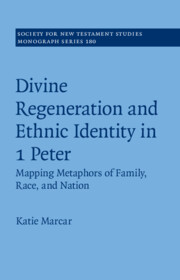Book contents
- Divine Regeneration and Ethnic Identity in 1 Peter
- Society for New Testament Studies
- Divine Regeneration and Ethnic Identity in 1 Peter
- Copyright page
- Dedication
- Contents
- Figures
- Tables
- Acknowledgments
- Note on the Text
- Abbreviations
- Introduction
- 1 Ethnicity Ancient and Modern
- 2 A Field Guide to Metaphors
- 3 The Structure of 1 Peter
- 4 Begotten Anew
- 5 Seed Metaphors in Jewish and Early Christian Literature
- 6 Newborn Babies and Spiritual Milk in 1 Peter 2:1–3
- 7 From House to House of God
- 8 From (Re)Generation to Ethnos
- 9 Conclusion
- Appendix The Language of Rebirth in Rabbinic Judaism
- Bibliography
- Subject Index
- Ancient Sources Index
5 - Seed Metaphors in Jewish and Early Christian Literature
Published online by Cambridge University Press: 01 June 2022
- Divine Regeneration and Ethnic Identity in 1 Peter
- Society for New Testament Studies
- Divine Regeneration and Ethnic Identity in 1 Peter
- Copyright page
- Dedication
- Contents
- Figures
- Tables
- Acknowledgments
- Note on the Text
- Abbreviations
- Introduction
- 1 Ethnicity Ancient and Modern
- 2 A Field Guide to Metaphors
- 3 The Structure of 1 Peter
- 4 Begotten Anew
- 5 Seed Metaphors in Jewish and Early Christian Literature
- 6 Newborn Babies and Spiritual Milk in 1 Peter 2:1–3
- 7 From House to House of God
- 8 From (Re)Generation to Ethnos
- 9 Conclusion
- Appendix The Language of Rebirth in Rabbinic Judaism
- Bibliography
- Subject Index
- Ancient Sources Index
Summary
After an introduction (§5.1), this chapter investigates the uses of metaphorical seed language in the Hebrew scriptures (§5.2), Greco-Roman Judaism (§5.3), the New Testament (§5.4), and finally 1 Peter (§5.5). In the Hebrew scriptures, seed language is completely human, though invested with divine promise. This chapter will then look at how the concept of “holy seed” was democratized to all Israel in Ezra and Jubilees (§5.2.4 - 3.3.1). This democratization went hand in hand with the strong concern for Israel’s corporate holiness. The New Testament (§5.4) usage of the seed idiom reflects contemporary Jewish usage. However, a new question was on the table for early Christians: how were Gentiles to be brought into the people of God and included as Abraham’s seed? Philo seems to be the first Jew to actively discuss divine seed, but with Stoic influences (§5.3.2). Divine seed is rare in the New Testament (§5.4). Despite claims (cf. Jn 3:5, 1 Jn 3:9), 1 Peter is the only New Testament text to discuss seed endowed with divine qualities that generates believers (§5.5). This chapter examines 1 Peter’s continuity with tradition, but also its innovation.
- Type
- Chapter
- Information
- Divine Regeneration and Ethnic Identity in 1 PeterMapping Metaphors of Family, Race, and Nation, pp. 118 - 168Publisher: Cambridge University PressPrint publication year: 2022

